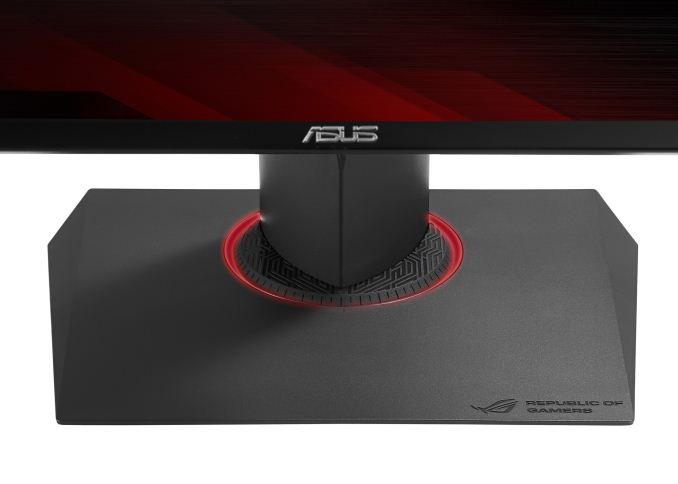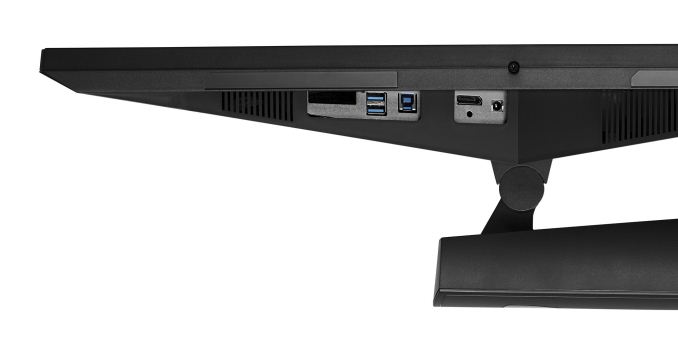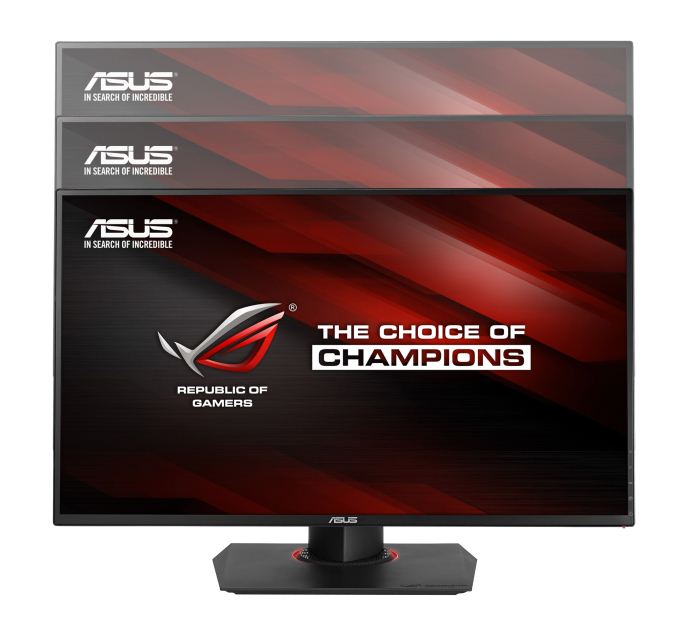ASUS ROG Swift PG278Q Monitor Released in APAC/EU, North America Coming September
by Ian Cutress on July 24, 2014 5:49 AM EST
One of ASUS’ many releases during Computex was for their new ROG Swift PG278Q monitor that boasted a number of impressive specifications all at once. The PG278Q combines a 2560x1440 panel capable of 120/144 Hz operation with support for NVIDIA G-Sync and 3D Vision, putting it firmly in the region of gaming and hence the ROG moniker.
Aside from NVIDIA G-Sync, the PG278Q comes with a Turbo Key on the rear for quick selection between 60 Hz, 120 Hz and 144 Hz depending on user preference. The GamePlus hotkey gives a crosshair overlay to enhance the gaming environment (useful in games that do not offer steady central crosshairs), as well as timer functions. The OSD is navigated by a joystick-like nub behind the side of the monitor.
Response time is listed as 1ms GTG, with 16.7M colors and 160-170º viewing angles. Connectivity is via DisplayPort 1.2 only, with a USB 3.0 pass-through hub also in the electronics. VESA support is for 100x100mm, and the monitor is listed at 7.0 kg (15.4 lbs). The PR gives a bezel dimension of 6 mm.
Due to the high refresh rate and inclusion of G-Sync, the Swift comes in as one of the most expensive TN panels on the market. Pricing will start at $799, varying by region, and the monitor should be available in Taiwan, APAC and EU today, with China in mid-August and North America by the end of August.
| ASUS ROG Swift PG278Q | |
| Display | 27-inch (68.5cm) widescreen with 16:9 aspect ratio |
| Resolution |
2D mode: 2560 x 1440 (up to 144 Hz) 3D mode: 2560 x 1440 (up to 120 Hz) 2D/3D surround: 7680 x 1440 (2D up to 144 Hz / 3D up to 120 Hz) |
| Pixel pitch | 0.233mm / 109 PPI |
| Colors (max) | 16.7M |
| Viewing angles | 170-degree (H) / 160-degree (V) |
| Brightness (max) | 350cd/m² |
| Response time | 1ms (GTG) |
|
ASUS-exclusive technologies |
ASUS GamePlus Technology (Crosshair / Timer) ASUS Refresh Rate Turbo Key (60 Hz /120 Hz/ 144Hz Overclocking) ASUS 5-way OSD Navigation Joystick |
|
NVIDIA® technologies |
NVIDIA® G-SYNC™ Technology NVIDIA® 3D Vision™ Ready NVIDIA® Ultra Low Motion Blur Technology |
| Input/output |
1 x DisplayPort 1.2 2 x USB 3.0 (Upstream x 1, Downstream x 2) |
| Stand |
Tilt: +20°~-5°, Swivel: ±60°, Pivot: 90° clockwise Height adjustment: 0~120mm VESA wall mount: 100 x 100mm |
| Size | 619.7 x 362.96 x 65.98mm |
| Weight (est.) | 7.0kg |
Source: ASUS















74 Comments
View All Comments
Spunjji - Friday, July 25, 2014 - link
You really can make innocent statistics say some funny things if you try hard enough.chizow - Friday, July 25, 2014 - link
Except in this case, those "innocent statistics" bear out what I said and directly refute the notion AMD didn't profit from those price hikes. Just takes a small bit of accounting knowledge and some common sense, because as a shareholder, I'd want to know why AMD *wasn't* profitting from those price hikes while they were having inventory issues.chaosbloodterfly - Thursday, July 24, 2014 - link
Samsung U28D590D is on Amazon for $600. Does 4k@ 60Hzdoggghouse - Thursday, July 24, 2014 - link
TFT Central has a thorough review of this monitor... the display is a step above normal TN because it's an 8-bit color panel instead of 6-bit. Also, they appear to be well calibrated right out of the box.But yes, this screen is TN, which means it will have the regular problems like contrast shifting at different angles. However, you won't find any (high quality) 120Hz IPS panels in the foreseeable future. From what I've read, overclocked IPS panels have image degradation problems. So it's a trade-off.
Maybe in a year or two, someone will release a 4K IPS that has G/Free-Sync at 60Hz. I think Acer has their 4K G-Sync panel coming soon, but it will also be TN.
Death666Angel - Thursday, July 24, 2014 - link
"overclocked IPS panels have image degradation problems" I've not read too many people complain about their image when overclocking their Korean IPS monitors and doing a recalibration with the right tools. I'm happy with my 320€ 1440p110Hz monitor, same IQ as my Samsung 1440p60Hz before it. The ROG is great if you have money to burn and are in the nVidia camp and intend to stay there.SlyNine - Thursday, July 24, 2014 - link
Because people like to justify their purchases. unless you do some objective testing for motion resolution, I remain unconvinced.Spunjji - Friday, July 25, 2014 - link
It's a fair point. Properly performed objective testing is what we're after here.Death666Angel - Saturday, July 26, 2014 - link
So you make a statement, I question the validity of it because I have not encountered people claiming the same and you ask me for proof? Where is your proof, my friend.doggghouse - Monday, July 28, 2014 - link
Honestly I haven't read much about overclocking IPS panels, but I could've sworn that I read something about colors getting a bit out of whack after an overclock. Though I suppose that could be fixed with calibration. One thing I wonder though, is the pixel response time actually good enough to display over 60 frames/sec? For example, I have an Alienware laptop with 120Hz TN display, but it's almost worthless (especially for 3D) because the frames blur together anyway due to slow pixel response. I imagine IPS would have the same problem...?bunnyfubbles - Thursday, July 24, 2014 - link
because this monitor is built for speedmotion clarity is one factor in determining image quality. IPS is the reigning champ for static image quality, but IPS is also much slower than TN. That being said, ASUS is using an 8bit 1440p TN panel (most TN panels are 6bit and 1080p or less) and early reviews are showing it to be competitive for static image quality, all while not sacrificing the speed as it is one of the fastest monitors you can buy.
As for why not 4K, well again, this monitor is built for speed, and 1440p @ 120 or 144Hz is just as demanding if not moreso than 4K @ 60Hz, either format requires Displayport 1.2 level bandwidth or better (this monitor is so demanding that a triple screen surround setup requires at least TriSLI because each monitor demands its own unique DP1.2 connection)
There are already plenty of 4K monitors on the market, ASUS even produces a 28" 4K 10bit TN panel monitor that goes for ~$650, but there are zero monitors that offer what the Swift does.